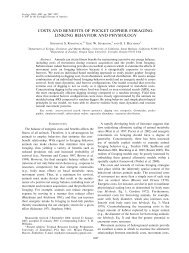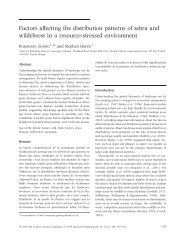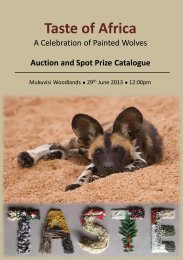The feeding ecology of the aardvark Orycteropus afer - ResearchGate
The feeding ecology of the aardvark Orycteropus afer - ResearchGate
The feeding ecology of the aardvark Orycteropus afer - ResearchGate
You also want an ePaper? Increase the reach of your titles
YUMPU automatically turns print PDFs into web optimized ePapers that Google loves.
152 W. A. TAYLOR ET AL.Daniels, C. (1984). Some aspects <strong>of</strong> habitat utilization and <strong>feeding</strong> <strong>ecology</strong> <strong>of</strong> <strong>the</strong> <strong>aardvark</strong><strong>Orycteropus</strong> <strong>afer</strong>. B.Sc. (Hons) <strong>the</strong>sis, University <strong>of</strong> Natal, Pietermaritzburg. 71 pp.Hinton, H.E. (1981). Biology <strong>of</strong> Insect Eggs, Vol. 1. New York: Pergamon Press. 172 pp.H<strong>of</strong>fman, T. (1996). Eastern Mixed Nama Karoo. In: Low, A.B. & Rebelo, A.G. (Eds),Vegetation <strong>of</strong> South Africa, Lesotho and Swaziland, pp. 52–57. Pretoria: Dept EnvironmentalAffairs and Tourism. 85 pp.Lindsey, P.A. & Skinner, J.D. (2001). Ant composition and activity patterns as determined bypitfall trapping and o<strong>the</strong>r methods in three habitats in <strong>the</strong> semi-arid Karoo. Journal <strong>of</strong> AridEnvironments, 48: 551–568.Manly, B.F.J. (1991). Randomization and Monte Carlo Methods in Biology. London: Chapman andHall. 281 pp.Melton, D.A. (1976). <strong>The</strong> biology <strong>of</strong> <strong>aardvark</strong> (Tubulidentata-Orycteropodidae). MammalReview, 6: 75–88.Melton, D.A. & Daniels, C. (1986). A note on <strong>the</strong> <strong>ecology</strong> <strong>of</strong> <strong>the</strong> <strong>aardvark</strong>, <strong>Orycteropus</strong> <strong>afer</strong>. SouthAfrican Journal <strong>of</strong> Wildlife Research, 16: 112–114.Montgomery, G.G. (1985). Impact <strong>of</strong> vermilinguas (Cyclopes, Tamandua: Xenartha"Edentata)on arboreal ant populations. In: Montgomery, G.G. (Ed.), <strong>The</strong> Evolution and Ecology <strong>of</strong>Armadillos, Sloths and Vermilinguas, pp. 351–363. Washington: Smithsonian Institution Press.451 pp.Nel, P.J., Taylor, W.A., Haupt, M.A. & Meltzer, D.G.A. (2000). Capture and immobilization <strong>of</strong><strong>aardvark</strong> (<strong>Orycteropus</strong> <strong>afer</strong>) using different drug combinations. Journal <strong>of</strong> <strong>the</strong> South AfricanVeterinary Association, 71: 58–63.Putman, R.J. (1984). Facts from faeces. Mammal Review, 14: 79–97.Redford, K.H. (1983). Mammalian myrmecophagy: <strong>feeding</strong>, foraging and food preference. Ph.D.<strong>the</strong>sis, Harvard University, Cambridge, MA. 299 pp.Redford, K.H. (1985). Feeding and food preference in captive and wild giant anteaters. Journal <strong>of</strong>Zoology, 205: 559–572.Redford, K.H. (1987). Ants and termites as food: patterns <strong>of</strong> mammalian myrmecophagy. In:Genoways, H.H. (Ed.), Current Mammalogy. Vol. 1. pp. 349–399. New York: Plenum Press.513 pp.Richardson, P.R.K. (1987). Aardwolf: <strong>the</strong> most highly specialised myrmecophagous mammal?South African Journal <strong>of</strong> Science, 83: 405–410.Rockstein, M. (1978). Biochemistry <strong>of</strong> Insects. New York: Academic Press. 649 pp.Samways, M.J. (1983). Community structure <strong>of</strong> ants (Hymenoptera: Formicidae) in a series <strong>of</strong>habitats associated with citrus. Journal <strong>of</strong> Applied Ecology, 20: 833–847.Skinner, J.D. & Smi<strong>the</strong>rs, R.H.N. (1990). <strong>The</strong> Mammals <strong>of</strong> <strong>the</strong> Sou<strong>the</strong>rn African Subregion (2ndEdn), Pretoria: University <strong>of</strong> Pretoria. 771 pp.Smi<strong>the</strong>rs, R.H.N. (1971). <strong>The</strong> Mammals <strong>of</strong> Botswana. Museums Memoir. National Museums andMonuments <strong>of</strong> Rhodesia, 4: 188–199.Smi<strong>the</strong>rs, R.H.N., & Wilson, V.J. (1979). Check list and atlas <strong>of</strong> <strong>the</strong> mammals <strong>of</strong> ZimbabweRhodesia. Museum Memoir, 9: 147 pp.Steyn, J.J. (1954). <strong>The</strong> pugnacious ant (Anoplolepis custodiens Smith) and its relation to <strong>the</strong> control<strong>of</strong> citrus scales at Letaba. Memoirs <strong>of</strong> <strong>the</strong> Entomological Society <strong>of</strong> South Africa, 3: 1–96.Swart, J.M. (1996). Foraging behaviour <strong>of</strong> <strong>the</strong> Cape pangolin Manis temminckii in <strong>the</strong> Sabi SandWildtuin. M.Sc. <strong>the</strong>sis, University <strong>of</strong> Pretoria, Pretoria. 149 pp.Swart, J.M., Richardson, P.R.K. & Ferguson, J.W.H. (1999). Ecological factors affecting <strong>the</strong><strong>feeding</strong> behaviour <strong>of</strong> pangolins (Manis temminckii ). Journal <strong>of</strong> Zoology, 247: 281–292.Werger, M. J. A. (1973). An account <strong>of</strong> <strong>the</strong> plant communities <strong>of</strong> Tussen die Riviere Game Farm,Orange Free State. Bothalia, 11: 165–176.Willis, C.K., Skinner, J.D., & Robertson, H.G. (1992). Abundance <strong>of</strong> ants and termites in <strong>the</strong>False Karoo and <strong>the</strong>ir importance in <strong>the</strong> diet <strong>of</strong> <strong>the</strong> <strong>aardvark</strong>, <strong>Orycteropus</strong> <strong>afer</strong>. African Journal <strong>of</strong>Ecology, 30: 322–334.





